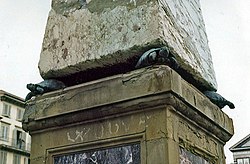
Tortoises as the supporting agent
The World Turtle (also referred to as the Cosmic Turtle, the World-bearing Turtle, or the Divine Turtle) is a mytheme of a giant turtle (or tortoise) supporting or containing the world. The mytheme, which is similar to that of the World Elephant and World Serpent, occurs in Hindu, Chinese, and Native American mythology. The "World-Tortoise" mytheme was discussed comparatively by Edward Burnett Tylor (1878:341).
North America[]
The Lenape myth of the "Great Turtle" was first recorded between 1678 and 1680 by Jasper Danckaerts. The myth is shared by other Northeastern Woodlands tribes, notably the Iroquois.[1]
China[]
In Chinese mythology the creator goddess Nüwa cut the legs off the giant sea turtle Ao (鳌) and used them to prop up the sky after Gong Gong damaged the Buzhou Mountain that had previously supported the heavens.
India[]
Hindu mythology has various account of World Tortoises, besides a World Serpent (Shesha), Kurmaraja and world-elephants.
The most widespread name given to the tortoise is Kurma or Kurmaraja. The Shatapatha Brahmana identifies the earth as its lower shell, the atmosphere as its body and the vault of heaven as its upper shell.
The name Akūpāra (the Sanskrit for "unbounded") is mentioned in the Bhagavata Purana.
An alleged tortoise Chukwa supporting Mount Meru is reported by Leveson Venables Vernon-Harcourt in 1838.[2] Vernon-Harcourt claims that this Chukwa was introduced to bishop Heber "in the Vidalaya school in Benares [by] an astronomical lecturer" (sic; vidyalaya is the Sanskrit for "school"). Chukwa along with Maha-padma (spelled "Maha-pudma") as the name of a world-elephant mentioned in the Ramayana has subsequently made it into Brewer's Dictionary of Phrase and Fableand was further repeated by reference to that work. The concept of World-Tortoise and World-Elephant was conflated in popular or rhetorical references to Hindu mythology. The combination of tortoise and elephant is present in John Locke's 1690 tract An Essay Concerning Human Understanding, which references an "Indian who said the world was on an elephant which was on a tortoise ". It is repeated in Bertrand Russell's 1927 Why I Am Not A Christianin the reference to "the Hindu's view, that the world rested upon an elephant and the elephant rested upon a tortoise". A whimsical allusion to such a supposed "tortoise-and-elephant" version of the myth appears in Wilfrid Sellars' 1956 Empiricism and the Philosophy of Mind:
- authoritative nonverbal episodes... would constitute the tortoise on which stands the elephant on which rests the edifice of empirical knowledge.
In popular culture[]
- Terry Pratchett's Discworld also parodies the supposed tortoise-and-elephants cosmological myth, with the "Giant Star Turtle" Great A'Tuin carrying four elephants on its back which in turn support the world on their backs.
- Stephen King uses this motif in his mythology. A turtle named Maturin is one of the Guardians of the Dark Tower, which is the center of the Multiverse. The same turtle, Maturin, appears in King's novel IT wherein it is the brother and the polar opposite of the antagonistic IT, with the turtle being IT's worst enemy. Maturin is responsible for creating galaxies and universes; he says he made the universe, but is not to be blamed as he had bellyache at the time.
- The Pokémon Torterra, is based on the concept of the World Turtle as it carries a tree, miniature mountains, and even other Pokémon on its back shell. Torterra is also called the Continent Pokémon, contributing to the idea that it was based on the World Turtle.
References[]
- ↑ Why the World is on the Back of a Turtle - Miller, Jay; Man, Royal Anthropological Institute of Great Britain and Ireland, New Series, Vol. 9, No. 2 (Jun., 1974), pp. 306–308, including further references within the cited text)
- ↑ L. Vernon Harcourt (1838). The doctrine of the Deluge: vindicating the scriptural account from the doubts which have recently been cast upon it by geological speculations. London: Longmans. pp. 250. http://www.archive.org/details/cu31924095279448.
| This page uses content from the English Wikipedia. The original article was at World Turtle. The list of authors can be seen in the page history. |